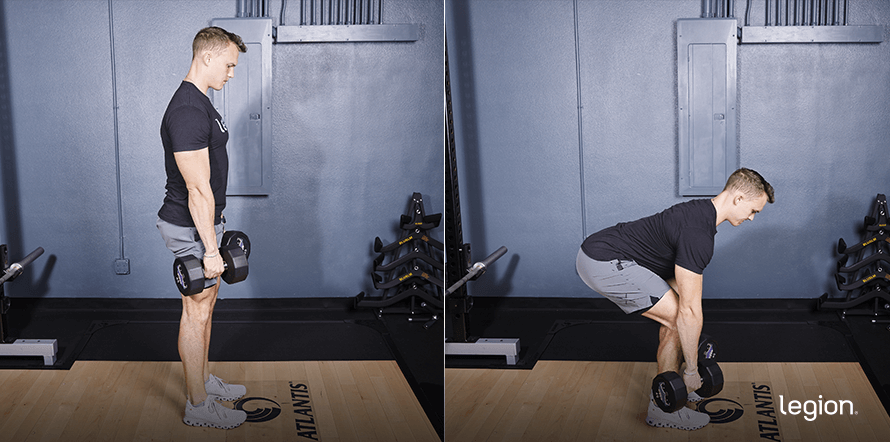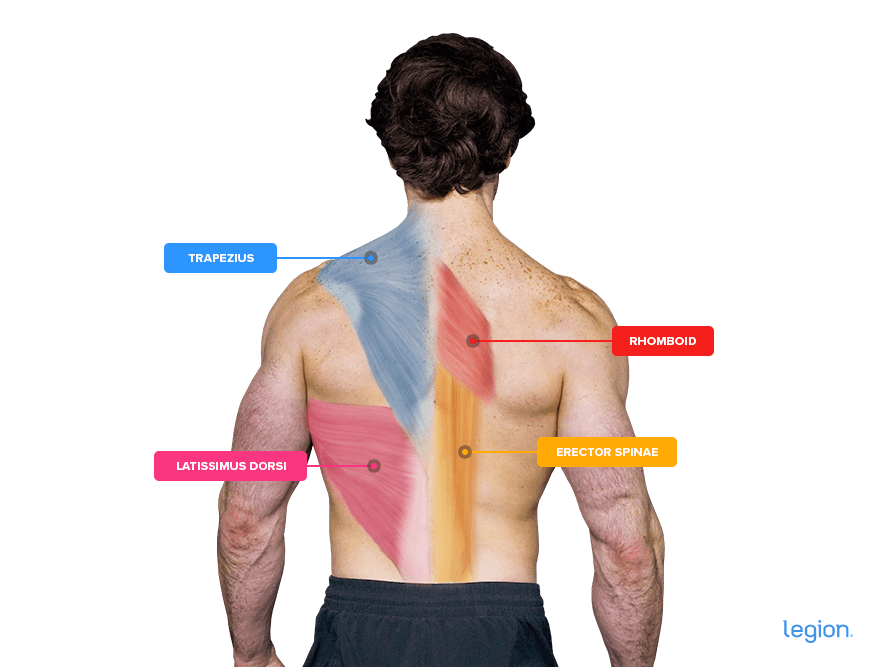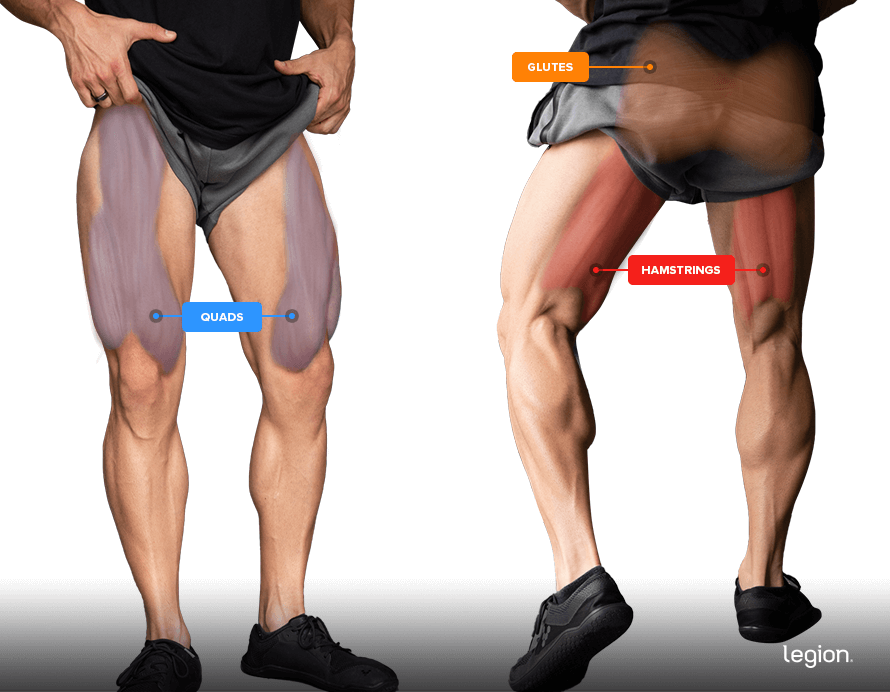Despite what some gymgoers say, you don’t need a barbell to do deadlifts.
Deadlifting with dumbbells is a simple, effective, and accessible alternative that can actually be better in certain situations.
For example, dumbbell deadlifts are an excellent option for beginners who haven’t developed the strength to lift a barbell yet. They’re also perfect for home workouts, as they require minimal space and equipment.
But just like with the barbell version, you have to know how to perform the dumbbell deadlift to reap its benefits and avoid injury. It may seem as simple as picking up and putting down weights, but there’s a lot more to dumbbell deadlift form than that.
In this article, you’ll learn exactly how to do the deadlift with dumbbells. You’ll also discover which muscles it trains, why it’s beneficial, and more.
Table of Contents
+
How to Do Proper Dumbbell Deadlift Form
The simplest way to learn how to deadlift with dumbbells is to split the exercise into three parts: set up, lift, and descend.

1. Set up
Stand up tall with a dumbbell in each hand. Move your hands in front of your thighs with your palms facing you, allowing the dumbbells to rest gently against your legs.
Take a deep belly breath and brace your core like you’re about to take a punch, squeeze the dumbbells as hard as you can, and press your upper arms into your sides.
2. Descend
While keeping your arms straight and the dumbbells directly beneath your shoulders, hinge at the hips, bend your knees, and slightly arch your lower back.
Allow your knees to bend slightly more as the dumbbells pass them, and keep descending until the dumbbells are 6-to-8 inches from the floor.
3. Lift
Drive your body upward by pushing through your heels, keeping your arms straight, lower back slightly arched, and core tight.
Ensure that your hips and shoulders rise together and at the same rate. Don’t shoot your hips up and then use your back like a lever to raise the dumbbells.
Once the dumbbells pass your knees, push your hips forward as you return to the starting position. When you’re fully upright, push your chest out and pull your shoulders down. Avoid leaning back, hyperextending your lower back, or shruging the dumbbells up.
Here’s how to should look when you put it all together:

Dumbbell Deadlift Benefits
Full-Body Muscle Growth
Deadlifting with dumbbells trains multiple major muscle groups throughout the body. For instance, it helps develop the lats, traps, rhomboids, lower back, glutes, hamstrings, and calves on your back, while also working the quads, forearms, core, and shoulders on your front.
RELATED: What Muscles Do Deadlifts Work? An Answer, According to Science
Reduced Injury Risk
Many people train their quads more than their hamstrings. This can cause muscle imbalances that increase your risk of injuries, especially to the hamstrings and knee. Deadlifting with dumbbells strengthens your hamstrings, which helps correct this imbalance and potentially reduces your risk of injury.
Increased Functional Strength
A dumbbell deadlift is a hip hinge—a movement that involves bending at the waist to pick something off the ground. Hip hinge strength is essential for various everyday tasks, such as picking up objects or children. Performing the deadlift with dumbbells strengthens the muscles involved in hip hinging, which makes these types of day-to-day activities easier.
RELATED: 6 Hip-Dominant Exercises for Glute and Hamstring Growth
What Do Dumbbell Deadlifts Work?
Dumbbell deadlifts train the following muscles:
- Latissimus dorsi (lats)
- Trapezius (traps)
- Rhomoids
- Spinal erectors (lower back)
- Glutes
- Hamstrings
- Quadriceps (quads)
- Core
It also trains your grip strength (forearms) and shoulders to a lesser degree.
Here’s how the main muscles worked by the dumbbell deadlift look on your body:


The 3 Best Dumbbell Deadlift Variations
1. Dumbbell Romanian Deadlift
The dumbbell Romanian deadlift trains the muscles on the back of your body similarly to the regular dumbbell deadlift. However, because of the difference in form, it emphasizes your hamstrings rather than your back.
A major benefit of the dumbbell Romanian deadlift is that it’s less fatiguing than the conventional deadlift with dumbbells, so you can do it more often without wearing yourself out.
RELATED: How to Do the Romanian Deadlift: Form, Benefits, and Variations
2. Dumbbell Sumo Deadlift
The sumo deadlift with dumbbells trains many of the same muscles as the regular dumbbell deadlift. The only minor difference is that the sumo dumbbell deadlift probably trains your quads slightly more, while the conventional dumbbell deadlift likely emphasizes your back muscles.
So, if you want to prioritize quad growth, choose the sumo dumbbell deadlift. Or, if you want to bulk up your lower back, stick to the regular dumbbell deadlift.
RELATED: The Definitive Guide to the Sumo Deadlift
3. Single-Leg Dumbbell Deadlift
The single-leg dumbbell Romanian deadlift has two main benefits: First, it trains each side of your body independently, so it’s useful for finding and fixing muscle imbalances. And second, because it’s inherently less stable than other dumbbell deadlift variations, it trains smaller stabilizer muscles—such as the glute minimus—more effectively.
FAQ #1: Are dumbbell deadlifts effective?
Yes, deadlift with dumbbells is effective for gaining whole-body muscle. They may also lower injury risk, especially to the hamstrings and knees, and help you develop strength that makes everyday tasks easier.
FAQ #2: Are dumbbell deadlifts as good as barbell deadlifts?
It depends on your goals and circumstances. The dumbbell deadlift is an excellent variation for people who have limited equipment and space for training. It also works well for those who aren’t strong enough to deadlift a barbell (yet!), since they can start lighter and build strength gradually.
On the other hand, the barbell deadlift allows you to handle heavier weights, so it’s better suited to people looking to maximize muscle and strength gain.
RELATED: How to Deadlift with Proper Technique
FAQ #3: Is the DB deadlift good for glutes?
Yes, all dumbbell deadlift variations are good for training the glutes, so if glute development is a top priority, including the DB deadlift in your routine is a good idea.
RELATED: Growing Your Butt: Best Glute-Focused Exercises
FAQ #4: What are the most common dumbbell deadlift form mistakes?
Here are the most common dumbbell deadlift form mistakes and how to fix them:
- Rounding the back: Rounding your back as you lift or lower the weight can lead to injury. Avoid this by bracing your core and engaging your lats throughout each rep.
- Letting the weights drift away from you: When you deadlift with dumbbells, it’s easy for the weights to drift away from your legs, which reduces your lifting efficiency and increases injury risk. To prevent this, imagine crushing oranges in your armpits. This “switches on” your lats and keeps the weights close.
- Hyperextending at the top of each rep: Overarching your back at the top of each rep can stress your lower back. Instead of leaning back, finish each rep with a flat back. Focus on driving through your glutes rather than using your back to lever the weight up.
Scientific References +
- Holcomb, William R., et al. “Effect of Hamstring-Emphasized Resistance Training on Hamstring:Quadriceps Strength Ratios.” The Journal of Strength and Conditioning Research, vol. 21, no. 1, 2007, p. 41, https://doi.org/10.1519/r-18795.1.
- Begalle, Rebecca L., et al. “Quadriceps and Hamstrings Coactivation during Common Therapeutic Exercises.” Journal of Athletic Training, vol. 47, no. 4, July 2012, pp. 396–405, www.ncbi.nlm.nih.gov/pmc/articles/PMC3396299/, https://doi.org/10.4085/1062-6050-47.4.01.
- Lee, Sangwoo, et al. “An Electromyographic and Kinetic Comparison of Conventional and Romanian Deadlifts.” Journal of Exercise Science & Fitness, vol. 16, no. 3, Dec. 2018, pp. 87–93, https://doi.org/10.1016/j.jesf.2018.08.001.
- ESCAMILLA, RAFAEL F., et al. “A Three-Dimensional Biomechanical Analysis of Sumo and Conventional Style Deadlifts.” Medicine & Science in Sports & Exercise, vol. 32, no. 7, July 2000, pp. 1265–1275, https://doi.org/10.1097/00005768-200007000-00013.
- ESCAMILLA, RAFAEL F., et al. “An Electromyographic Analysis of Sumo and Conventional Style Deadlifts.” Medicine & Science in Sports & Exercise, vol. 34, no. 4, Apr. 2002, pp. 682–688, https://doi.org/10.1097/00005768-200204000-00019.
- Cholewicki, J., et al. “Lumbar Spine Loads during the Lifting of Extremely Heavy Weights.” Medicine and Science in Sports and Exercise, vol. 23, no. 10, 1 Oct. 1991, pp. 1179–1186, pubmed.ncbi.nlm.nih.gov/1758295/.










